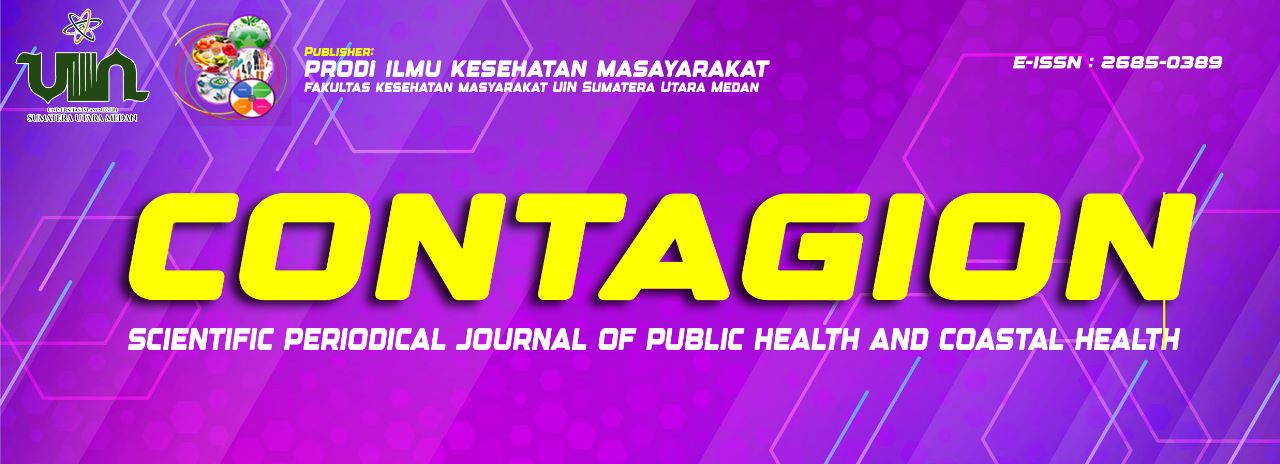Maternal Work Status and Nutritional Knowledge as Predictors of Toddler Stunting: Evidence from Asahan Regency, Indonesia
Abstract
Stunting remains a significant public health concern in Indonesia, particularly in rural and semi-urban areas where maternal knowledge and employment status intersect with child-rearing practices. This study investigates the relationship between maternal employment, maternal knowledge, and the incidence of stunting among toddlers in the catchment area of the Simpang Empat Primary Healthcare Center, Asahan Regency. A quantitative, cross-sectional design was utilized, with data collected from 57 mothers of children aged 12–59 months via structured questionnaires distributed through Google Forms. Key variables included maternal employment status, maternal knowledge of child growth and nutrition, and child nutritional status measured by height-for-age Z-scores (HAZ), in accordance with the WHO Child Growth Standards (2006). Descriptive analysis revealed that 52.6% of mothers were unemployed, and 54.4% exhibited limited knowledge of early childhood development and nutrition. The prevalence of stunting in the sample was 43.8%. Bivariate analysis using the chi-square test identified statistically significant associations between stunting and both maternal employment status (p = 0.000) and maternal knowledge (p = 0.003). Notably, stunting was more prevalent among children whose mothers had poor nutritional knowledge, regardless of employment status. These findings underscore the dual influence of socioeconomic and cognitive factors on child nutritional outcomes. Maternal employment alone does not mitigate the risk of stunting unless accompanied by sufficient nutritional literacy and caregiving capacity. The study highlights the urgent need for community-based health education initiatives through primary healthcare centers and cadres, supported by flexible and inclusive maternal support programs that address time constraints and knowledge gaps. Strengthening maternal knowledge across socioeconomic strata is critical to achieving Indonesia’s national stunting reduction targets and advancing global child development goals
Keywords: Stunting, Maternal Work Status, Maternal Knowledge, Toddler Nutrition
Full Text:
PDFReferences
Adisasmito, W., & Adisasmita, A. (2023). Health system resilience during and after COVID-19 pandemic in Indonesia. Journal of Global Health Science, 5(1), 100–108. https://doi.org/10.35500/jghs.2023.5.e10
Apriliani. (2025). Utilization of Primary Healthcare Services and Stunting Among Children Aged 0–59 Months in Indonesia: A National Cross-Sectional Study. Contagion : Scientific Periodical of Public Health and Coastal Health, 7(1), 404–414. https://doi.org/10.30829/contagion.v7i1.25425
Bahriyah, F. (2024). Hubungan Pekerjaan Ibu Dengan Status Gizi Balita Studi Kasus Di Desa Sukajadi. Public Health and Safety International Journal, 4(1), 25–28.
Bhutta, Z. A., Das, J. K., Rizvi, A., Gaffey, M. F., Walker, N., & Horton, S. (2020). Evidence-based interventions for improvement of maternal and child nutrition: what can be done and at what cost? The Lancet, 382(9890), 452–477. https://doi.org/10.1016/S0140-6736(13)60996-4
BKKBN. (2022). Strategi Percepatan Penurunan Stunting di Indonesia. Jakarta: BKKBN.
Black, R. E., Victora, C. G., Walker, S. P., Bhutta, Z. A., Christian, P., & de Onis, M. (2021). Maternal and child undernutrition and overweight in low-income and middle-income countries. The Lancet, 397(10285), 276–288. https://doi.org/10.1016/S0140-6736(21)00590-0
Central Bureau of Statistics. (2023). Indonesia Health Profile. Jakarta: BPS.
Dinas Kesehatan Sumatera Utara. (2024). Data Prevalensi Stunting Kabupaten/Kota. Medan: Dinkes Sumut.
Hapsari, R. (2018). Hubungan antara status pekerjaan ibu dengan kejadian stunting pada balita. Jurnal Kesehatan Masyarakat, 6(3), 179–185.
Hermanto, Y. (2021). Analisis Faktor Risiko Stunting di Wilayah Kerja Puskesmas. Jurnal Ilmu Kesehatan Masyarakat, 12(2), 145–153.
Irawati, D., & Arifin, A. (2020). Determinan Sosial Ekonomi terhadap Kejadian Stunting. Jurnal Epidemiologi Kesehatan Indonesia, 5(1), 23–30.
Kusnadi, E., & Wibowo, D. (2021). Komunikasi Perubahan Perilaku dalam Pencegahan Stunting: Peran Kader Posyandu. Jurnal Komunikasi Kesehatan Indonesia, 8(2), 117–125. https://doi.org/10.20473/jkki.v8i2.2021.117-125
Ministry of Health. (2024). Laporan Status Gizi Indonesia 2024. Jakarta: Kementerian Kesehatan Republik Indonesia.
Notoatmodjo S. (2012). Promosi Kesehatan dan Ilmu Perilaku. Rineka Cipta: Jakarta.
Putri, A. S., Lestari, P., & Adi, A. C. (2021). Pengetahuan Ibu dan Praktik Pemberian MP-ASI terhadap Kejadian Stunting. Jurnal Gizi Dan Pangan, 16(3), 207–216. https://doi.org/10.25182/jgp.2021.16.3.207-216
Putri, N. Z., & Lusida, N. (2024). Hubungan Status Pekerjaan Ibu Dengan Status Gizi Balita Puskesmas Menur Kota Surabaya. Ilmu Kesehatan, 12(4), 1–6. https://doi.org/10.5455/mnj.v1i2.644xa
Rachmad, R., & Fatmawati, D. (2022). Intervensi Terpadu Cegah Stunting pada Balita. Jurnal Kesehatan Komunitas, 10(3), 205–213.
Rosliani, R., & Wulandari, D. (2020). Mother’s Knowledge and Stunting Prevention Efforts. Jurnal Gizi Indonesia, 9(2), 88–95.
Satoto, T. B. T., & Ardini, R. (2022). Gizi dan Pengasuhan: Peran Ganda Ibu Bekerja di Perdesaan. Jurnal Kesehatan Reproduksi, 13(1), 55–64.
Silalahi, T. (2024). Program PIS-PK dan Tantangannya di Daerah Rawan Stunting. Jurnal Kebijakan Kesehatan, 15(1), 25–33.
SSGI. (2022). Survei Status Gizi Indonesia 2022. Jakarta: Kementerian Kesehatan Republik Indonesia.
Titaley, C. R., Ariawan, I., & Laksono, A. D. (2023). Analysis of maternal and child health interventions to accelerate stunting reduction in Indonesia. BMC Public Health, 23(1), 112–122. https://doi.org/10.1186/s12889-023-15174-1
UNDP. (2021). Social Protection and Nutrition in Indonesia. New York: United Nations Development Programme.
UNICEF. (2020). The State of Children in Indonesia. United Nations Children’s Fund (UNICEF). https://www.unicef.org/indonesia/sites/unicef.org.indonesia/files/2020-06/The-State-of-Children-in-Indonesia-2020.pdf
UNICEF Indonesia. (2023). Impact of COVID-19 on Nutrition Services in Indonesia. Jakarta: UNICEF.
Wahyuni, T. (2015). Pekerjaan ibu dan hubungannya dengan status gizi anak balita. Media Gizi Indonesia, 13(2), 121–126.
WHO. (2021). Levels and trends in child malnutrition. Geneva: World Health Organization.
World Bank. (2022). Investing in Human Capital for a Resilient Indonesia. DC: The World Bank.
Yuliasari, D., Indriyani, D., & Handayani, A. (2022). Peran Ibu Bekerja dalam Pemenuhan Gizi Balita di Masa Pandemi COVID-19. Jurnal Gizi Dan Kesehatan Indonesia, 14(1), 33–41. https://doi.org/10.14710/jgki.14.1.33-41
DOI: http://dx.doi.org/10.30829/contagion.v7i2.25432
Refbacks
- There are currently no refbacks.
Copyright (c) 2025 Mestika Rija Helti

This work is licensed under a Creative Commons Attribution-ShareAlike 4.0 International License.






